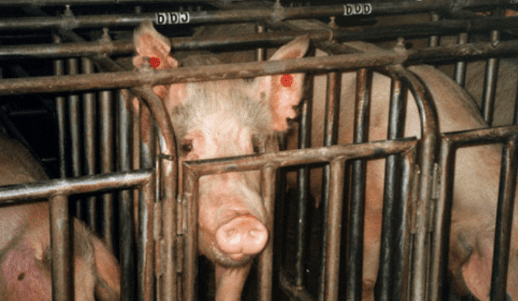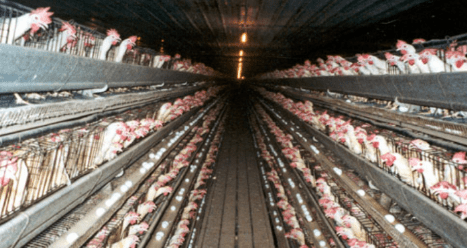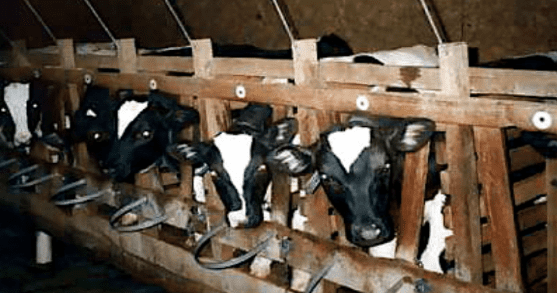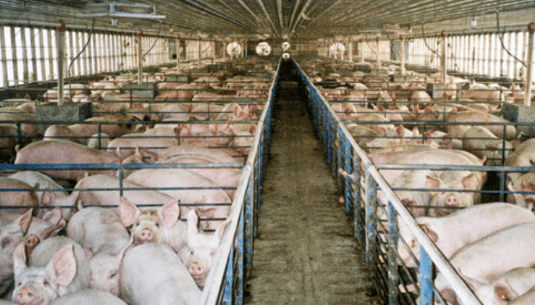The Truth About Where Food Comes From
American’s love for chicken, egg-laying hens, dairy cattle, calves (raised for veal), and pigs have resulted in the documented concentration practices within CAFOs for decades. Described as “scavenging conditions, with little attention to disease control, housing, or feed[ing],” animals in CAFOs are at the highest risk of endemic diseases due to their close contact with other livestock (11).
To illustrate this proximity, it’s advised that four egg-laying hens and chickens be placed into battery cages (Image 1)—identical cages connected together, in a unit, as in an artillery battery—but 5-10 chickens are more often crammed into this space instead, where each chicken has the amount of floor space equivalent to less than one sheet of letter size paper (12).
Egg-producing chicken are among the most abused livestock. To meet the demand for eggs, 280 million hens laid 77 billion eggs in battery cages like this in 2007 alone (12).
From hatching to slaughter, hens live in these cages for about 95% of their life, experiencing confinement, mutilation, and deprivation of natural social patterns (12). As the hens grow, they are habitually pressed into the wire cages, which rubs against their body and leads to feather loss, bruises and abrasions (12).
In battery cages, it’s impossible for hens to spread their wings, and even the act of standing on wire is abrasive to their feet. Stress from overcrowding and agitation go hand-in-hand; it fosters aggressive behaviors that forces them to step on or peck each other, thereby inflicting new wounds, sores, and infections (12).
Image 2
For dairy cattle, thousands can be packed into feedlots (i.e. zero-grazing opportunities), particularly in their last 3-4 months of feeding, where they are exclusively fed grains like corn (13). Feedlots are teeming with massive amounts of manure that can infect the cow’s hide with bacteria and seep into slaughterhouses and packaged foods if not properly dealt with at the facility (14). Furthermore, calves reared for veal are deprived from their mothers immediately upon birth and housed in veal crates for a majority of their lives (Image 2) (15). Calves share an immediate bond with their mothers in natural herds, often remaining grazing partners years after maturation. On dairy farms, calves are forcibly removed from their mothers shortly after birth and raised in veal crates (15).
Maternally deprived, denied of natural sucking behavior, unexposed to natural sunlight, and subject to residing in their own urine and feces, these calves spend the rest of their days in veal crates, ranging from 22-30 inches wide by 58-66 inches long (16-18). Once slaughtered, contamination of just one calf has the potential to contaminate thousands of pounds of meat (19).
IMAGE 3
Growing pigs face much of the same: packed on bare, concrete and slatted floors, and live on top of their excrement (20). Pregnant sows spend their pregnancy in metal enclosures or gestation crates that severely limit movement (Image 3) (21). Discomfort is compounded by the development of abnormal behaviors due to social isolation, as well as the growth of skin lesions due to the lack of thermal protection and local/systemic cold stress (22).
Breeding sows are tightly confined within gestation crates, which are lined up row after row in large sheds. Like egg-laying chickens and newborn calves, pigs experience extreme confinement and stress throughout their existence. Naturally curious and intelligent, pigs are denied the opportunity to engage in their natural foraging and socializing behavior. Female pigs are first impregnated at seven months, and subsequently live through confined cycles of pregnancy, birth, and nursing until slaughtered. Gestation crate floors are composed of slats, which allows their waste to fall directly through. Again, just like egg-laying chickens and newborn calves, sows, too, have to live directly above pooling piles of manure. As a result, sows are exposed to high levels of ammonia, and associated respiratory disease by design (21).
Standing on slatted flooring can lead to excessive hoof injuries, damage to joints, and lameness, an abnormal gait or stance. Lameness can be observed in pigs that stand with their back arched, head tucked down (to reduce the weight on their feed), and all four feet tucked under their body (21).
Boredom and frustration of confinement are thought to be responsible for abnormal behaviors like repetitively biting at the bars of the crate or chewing with an empty mouth.
How did the traditional, time-honored practice of animal husbandry transform so drastically into the inhumane, rapid-growth cycle that CAFOs embody?
In short, consumer demand sparked a competitive producer response. As Eric Schlosser, author of Fast Food Nation, writes, “The McNugget [of the early 1960s] helped change not only the American diet but also its system for raising and processing [its livestock].” The fast food industry had to revolutionize red meat and poultry processing in order to supply the demand for abundant and affordable animal proteins, which was an untapped market.
For the first time in human history, meat was no longer a luxury item only reserved for the wealthy—anyone could easily partake in this previously affluent culture, and there was substantial buy-in from the masses (23). As chains like McDonalds grew, consumers voted with their dollars, and the market listened. To meet the demand, the industry knew that their animals needed to grow rapidly in the smallest space and the fastest way possible in order to maximize profits. This explains why all cattle are fed corn in the last 4-5 months before being slaughtered (i.e. increasing weight gain and total fat content yields more product to sell).
Labelling of animal products such as “organic”, “grass-fed”, “pasture-raised”, “wild”, and “cage-free” have become popularized since customers want to continue imagining the best case scenario regarding farming practices. Unfortunately, these terms do not translate to what the reality actually is at the farm since consumers’ demand for animal protein remains increasingly high. Federal regulations and enforcement are extremely loose regarding these terms in animal farms since the incentive at the end of the day is to drive profits.
As long as consumers’ demand for animal protein continues to exponentially rise, the animal farming industry and government agencies have no real advantage to change practices even at the determinant of the environment and human health.
References
Tomley, F. M., & Shirley, M. W. (2009). Livestock infectious diseases and zoonoses, 364. Philosophical Transactions of the Royal Society B: Biological Sciences, 2637-2638.
Chickens, Farm Sanctuary. Retrieved from https://www.farmsanctuary.org/learn/factory-farming/chickens/ on Nov. 16, 2019.
Factory Farmed Cows. The National Humane Education Society. Retrieved from https://www.nhes.org/animal-info- 2/factory-farmed-animals-2/factory-farmed-cows/ on Nov. 16, 2019.
Van Donkersgoed, J. O. Y. C. E., Jericho, K. W., Grogan, H., & Thorlakson, B. (1997). Preslaughter hide status of cattle and the microbiology of carcasses. Journal of Food Protection, 60(12), 1502-1508.
Calves for Veal. Woodstock Farm Sanctuary. Retrieved from woodstocksanctuary.org/learn/animals-used-for-food/veal/ on Nov. 16, 2019.
Factory Farmed Cows. The National Humane Education Society. Retrieved from https://www.nhes.org/animal-info- 2/factory-farmed-animals-2/factory-farmed-cows/ on Nov. 16, 2019.
Wilson, L. L., Stull, C. L., & Terosky, T. L. (1996). Scientific advancements and legislation addressing veal calves in North America. In International Symposium: veal perspectives to the year 2000.[Symposium international: perspectives pour la viande de veau a l'an 2000], Le Mans (France), 12-13 Sep 1995. Federation de la Vitellerie Francaise.
Reinhardt, V., & Reinhardt, A. (1981). Cohesive relationships in a cattle herd (Bos indicus). Behaviour, 77(3), 121-150.
Problems. Factory Farm Map. Retrieved from https://www.factoryfarmmap.org/problems/ on Nov. 16, 2019).
On The Farm: Pigs. Animal Welfare Institute. Retrieved from https://awionline.org/content/pigs on Nov. 16, 2019.
Pork Production on Factory Farms. Pigs - Farm Sanctuary. Retrieved from https://www.farmsanctuary.org/learn/factory-farming/pigs-used-for-pork/ on Nov. 16, 2019.
An HSUS Report: Welfare Issues with Gestation Crates for Pregnant Sows. (2013). The Human Society of the United States. Retrieved from https://www.humanesociety.org/sites/default/files/docs/hsus-report-gestation-crates-for-pregnant-sows.pdf on Nov. 16, 2019.
Schlosser, E. (2012). Fast food nation: The dark side of the all-American meal. Chapter 6. Houghton Mifflin Harcourt.
AUTHOR
Dr. Payal Bhandari M.D. is one of U.S.'s top leading integrative functional medical physicians and the founder of SF Advanced Health. She combines the best in Eastern and Western Medicine to understand the root causes of diseases and provide patients with personalized treatment plans that quickly deliver effective results. Dr. Bhandari specializes in cell function to understand how the whole body works. Dr. Bhandari received her Bachelor of Arts degree in biology in 1997 and Doctor of Medicine degree in 2001 from West Virginia University. She the completed her Family Medicine residency in 2004 from the University of Massachusetts and joined a family medicine practice in 2005 which was eventually nationally recognized as San Francisco’s 1st patient-centered medical home. To learn more, go to www.sfadvancedhealth.com.




